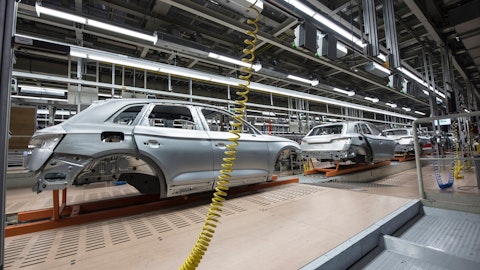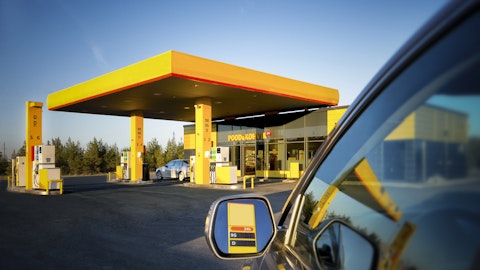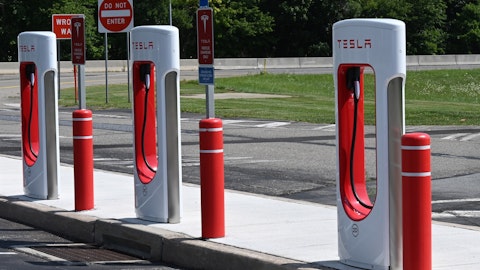That’s active now. We said on our last earnings call that even if we only had our — what we see as our opportunity share of fuel-cell trucks in California, there’s what we expect fuel cell trucks to make up of California’s decommerzation goals to 2030, we would take the company to its cash flow breakeven by 2030, just with California. The second step is ports, right? And that’s under the Inflation Reduction Act Clean Ports funding, which includes the zero-emission Port Equipment fund has $2.6 billion of funding with applications going in now and awards expected to be awarded starting in December of this year. And that’s up to $500 million per port, which includes drayage trucks and hydrogen refueling infrastructure. And we actually mentioned in the comments, we’re excited to have our joint application with a customer and a fueling partner to be selected by Port Houston to be a part of their application to that program.
So that’s the first example of Hyzon supporting application to go in, we’ll see — we hope that, that application is successful. There’s other ports that we’re in discussions with. And we see that as a critical program to put drayage trucks and filling infrastructure at major ports, both coastal and inland. And then the third step, is, of course, the DOE hydrogen hub program, which I think we’re all were $7 billion awarded to seven hubs, Hyzon is proud have supported several of the awarded hub and are currently actively working to help those subs lift and our fleet customers with applications. So we have tremendous opportunity we see on the truck side. On the fueling side, the 45 production tax credit in EIR is also critical to us and to the industry.
Now I think anyone is in hyrogen has seen the significant discussions going up to Congress about how that initial guidance has come back and what we all think are prudent changes that are critical to be made. Even without that 45 PTC, we still see a clear path and opportunity given we said publicly, we believe at 1,000 trucks per year, 1,000 fuel cell systems per year of capacity that we will be at a significant path towards TCO parity without meeting subsidy on the truck side. But that feels subsequent I think, is important to us. The last thing I’ll say is there’s other provisions that are under the radar that all help us get this cost down. One is the 45 W Clean Truck tax credit, which gives us the $40,000 per truck that we’re working right now to ensure that Hyzon trucks are able to qualify for.
So very clear path we see for subsidy. I think some of the major things to look for are continued deployments in applications by Hyzon customers under the California program. And then we’re all focused on this first application of the hope would to come in the zero emission port equipment funding with the words is currently slated for December of 2024.
Steven Fox: Great. That’s helpful perspective. Thank you.
Parker Meeks: Thank you, Steve.
Operator: Your next question comes from the line of Craig Irwin with ROTH MKM. Your line is open.
Craig Irwin: Good morning, gentlemen. Thank you for taking my questions. Parker, I just wanted to start off with the improved cash use. You guys seem to be tracking ahead of what you’re guiding us for earlier in 2023? And even ahead of sort of what you were discussing for the outlook for ’24. Can you maybe describe for us what’s working for you? Maybe some of the actions that you’ve taken that are getting these results?
Parker Meeks: Thanks so much, Craig, and great to hear your voice. So I’ll pass it over to Steve for comments.
Stephen Weiland: Yes. Craig, thanks for the question, and thanks for bringing it up. We’re really proud of our performance in managing cash burn expenses here at Hyzon. I think if you look at the numbers, you’ll see that just from Q1 ’23, our net cash burn was about $46 million. And here about $25.5 million, right? So that’s a significant reduction over the course of the year. And even if we had included that SEC payment in Q4, like I mentioned, we still would have come in that range. And so it really represents a number of things. It’s our renewed strategic focus really focusing the business on the most important things as we rolled out our new strategy early in the year. It’s driving cost efficiencies. And we’re also benefiting from, of course, seeing kind of legal and consulting and accounting fees come down as we move out of that investigation.
So right now, in that fourth quarter, that worked out to about $8.5 million of monthly average recurring cash burn. That level, sub-$10 million per month level is pretty representative of how the business is operating right now and we’re not giving guidance for the full year, but I think that’s pretty indicative of what we’re doing. And it also lets us continue to prioritize and invest in key areas of our technology and move that forward.
Parker Meeks: Yes. And I’ll just add to that, that we’re really proud of the fact that I feel — we believe we’re showing significant progress and a real inflection point that would reach commercialization, not just in the development towards SOP, the 200-kilowatt fuel cell system and our plant here in Bolingbrook in Chicago area, which we’re very excited about the upcoming SOP that we’re anticipating in the second half of this year. I mean just a major step, not just for us, but for the fuel cell industry in the U.S. and a plant like this coming online, and then additionally, with the Global Powertrain, I mean we’ve just brought the program and platform from Australia to the U.S., and we’re eager to get that leading refuse truck into trial here in the U.S. soon.




